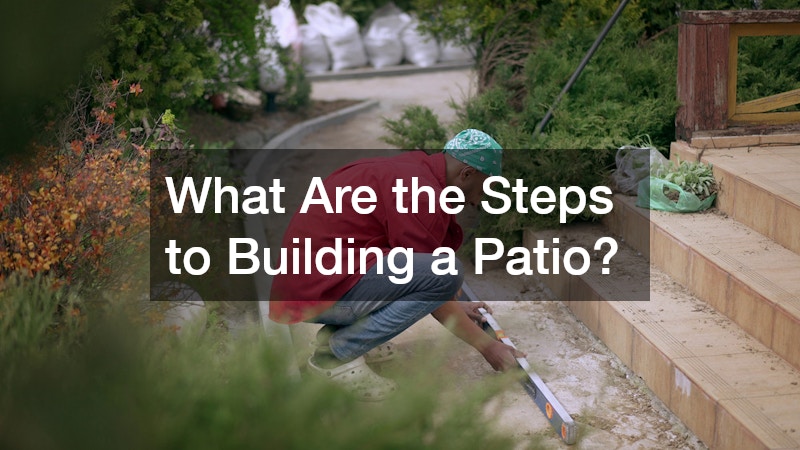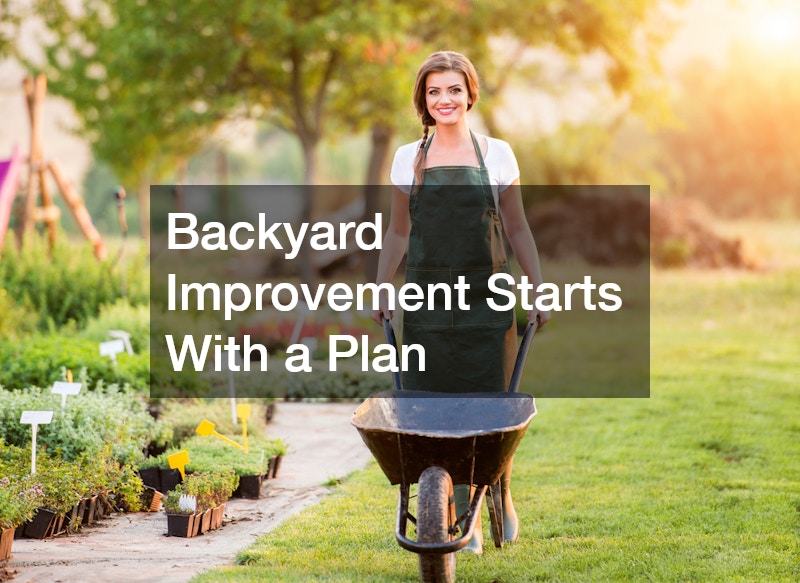A backyard improvement project is one of the most rewarding ways to enhance your property, improve your lifestyle, and create a welcoming space for friends and family. Whether you’re dreaming of a cozy patio, a lush garden, or a fully equipped outdoor kitchen, success starts with a clear plan. The planning stage lays the groundwork for every material, design choice, and budget decision you’ll make along the way.
How to Begin Planning Your Backyard Renovation?

Assessing Your Needs
Before breaking ground or purchasing materials, think about how you’ll use your backyard. Will it serve as an entertaining space? A place for children to play? A low-maintenance garden retreat? Your vision will help you prioritize features like patios, flower boxes, or irrigation installation. This is the time to list your non-negotiables and nice-to-haves.
Setting a Realistic Budget
Every backyard improvement project must work within a budget. Outline the full scope—including labor, materials, and any specialty work like tree removal or irrigation systems. Don’t forget to factor in long-term maintenance costs.
Understanding Your Space
Take detailed measurements of your backyard and note natural features such as tree locations, slopes, and drainage issues. Also, observe how sunlight moves across your yard during the day. These factors influence everything from where to place a patio to which plants will thrive.
What Are the Best Landscaping Design Ideas?
Incorporating Native Plants
Native plants are well-suited to local climates and soils, making them easier to maintain and more sustainable in the long run. They typically require less water, fewer fertilizers, and minimal upkeep.
Integrating flower boxes filled with native blooms can add vibrant color and attract pollinators like bees and butterflies. You can consult a landscape designer to select native varieties that also offer visual interest year-round.
Utilizing Hardscapes
Hardscaping includes non-plant features like walkways, retaining walls, patios, and edging. These elements provide structure and visual contrast. They also make your outdoor space more usable, especially during wet seasons or heavy foot traffic.
Designing for All Seasons
Don’t limit your backyard improvement to spring and summer functionality. A well-planned outdoor space can be enjoyable in every season. Consider adding a fire pit or covered patio for warmth and shelter.
How to Choose the Right Outdoor Furniture?
Considering Durability and Maintenance
Outdoor furniture must withstand sun, rain, and temperature fluctuations. Materials like teak, powder-coated aluminum, and all-weather wicker are popular for their durability. Look for cushions with removable, weather-resistant covers to make upkeep easier.
A common mistake in backyard improvement projects is investing in trendy pieces that don’t last. Choose items that can handle the elements and still look great after a few seasons. You’ll thank yourself later when the furniture still looks sharp without constant upkeep.
Choosing Style Over Trends
While it’s tempting to buy the most stylish set on display, aim for furniture that matches your long-term design vision. Think timeless rather than trendy. Your backyard should reflect your personal style, not just current fads.
Try pairing contemporary furniture with traditional flower boxes, or mixing industrial elements with rustic wooden benches. Consistency in design will make your outdoor space feel like a natural extension of your home.
Optimal Space Utilization
Even small backyards can feel spacious with the right layout. Opt for multi-functional furniture like benches with built-in storage or collapsible tables. If you’re planning to include pavers for a patio or dining area, be sure to leave adequate clearance for movement around the space.
What Are the Steps to Building a Patio?

Selecting Materials
The right materials will set the tone for your entire backyard. Pavers offer a classic and versatile look, while poured concrete tends to be more budget-friendly. Flagstone, brick, and even recycled materials can also be used depending on the style you’re going for.
Local pavers can help source materials that blend with your home’s exterior and landscaping. They may also have insights into which paver types are most durable for your region’s climate.
Installing a Solid Foundation
No matter the material, a patio is only as good as its foundation. Without a proper base, you risk sinking, shifting, or cracking. Most patios require excavation, compacted gravel, and a sand or mortar base before the final layer is installed.
Adding Personal Touches
Once the patio is installed, bring it to life with personal flair. Flower boxes, outdoor rugs, and string lights can make a new patio feel instantly welcoming. Think about how the space will be used and decorate accordingly—whether it’s an area for evening cocktails or weekend brunches.
You might also integrate bark mulch landscaping around the patio’s perimeter to blend the hardscape into the surrounding greenery.
How Do You Integrate Water Features?
Choosing the Right Type of Water Feature
From fountains and ponds to waterfalls and reflecting pools, water features can bring a calming, luxurious feel to your backyard improvement. Your choice will depend on space, budget, and how hands-on you want to be with maintenance.
Ensuring Proper Installation
Water features must be installed correctly to avoid leaks, mold, or electrical hazards. In many cases, irrigation installation specialists or electricians will need to be consulted, especially if the feature has pumps or lighting.
A landscape designer can help determine the best location—ideally where you’ll hear the water from your favorite seating area, but where it won’t interfere with pavers, trees, or flower beds.
Maintaining for Longevity
To get the most from your investment, establish a maintenance routine early. This may include checking pump filters, cleaning basins, and winterizing components. Some homeowners hire landscaping contractors for seasonal water feature maintenance to keep things hassle-free.
Also, consider surrounding your water feature with bark mulch landscaping to keep weeds at bay and preserve soil moisture for nearby plants.
How To Effectively Use Lighting In Your Backyard?
Backyard lighting does more than just extend usability past sunset—it defines your space, adds security, and creates a welcoming atmosphere. Whether you want to illuminate a path, highlight a flower box, or set a mood for evening gatherings, lighting deserves careful consideration.
Understanding Different Lighting Types
From string lights to in-ground LED spots, lighting types vary in intensity, color temperature, and purpose. Spotlights are great for showcasing pavers or trees pruned by your arborist, while ambient lights can soften the perimeter of your landscape. Task lighting near outdoor kitchens or seating areas ensures both safety and convenience.
Creating Ambiance Through Layers
Layered lighting provides depth and dimension. Combining ambient, accent, and task lighting gives you flexibility to tailor the mood to any occasion. Use uplighting to draw attention to vertical elements like pergolas or trellises, and downlighting to make pathways and hardscaping features feel more inviting.
This method not only adds visual interest but also keeps the entire yard feeling cohesive. Layering is especially effective in areas with mixed-use, such as patios with pavers or small gardens surrounded by flower boxes.
Energy Efficiency And Solar Options
Energy efficiency plays a big role in modern backyard design. Solar lighting options offer a low-maintenance, eco-friendly solution, especially when placed along garden paths or irrigation installation zones. LED bulbs consume far less electricity than traditional incandescent lighting, and many are now designed to withstand the elements year-round.
Sustainable lighting choices are a small but impactful part of larger backyard improvement goals—combining beauty, function, and responsibility.
What Are The Best Ways To Incorporate Shade?

Shade can make or break your backyard’s usability in the warmer months. From permanent structures to temporary fixes, there are plenty of ways to create a more comfortable outdoor experience.
Installing Pergolas And Gazebos
Pergolas and gazebos are ideal for those who want both shade and architectural charm. These structures pair well with hardscaping features like stone patios or wooden decks. A landscape designer may help determine optimal placement to maximize shade during peak sunlight hours, especially if you’re also using nearby pavers for walkways or seating areas.
These installations can also support climbing plants or vines, which add greenery and seasonal color without sacrificing durability.
Utilizing Natural Shade Solutions
If you prefer a more organic solution, trees offer excellent, long-lasting shade. Consult with an arborist to choose species that thrive in your climate and soil conditions. Planted strategically, trees can provide shade to patios, play areas, and outdoor kitchens, all while contributing to backyard privacy.
Flower boxes at the base of these trees can soften the space and create layered visual interest without compromising airflow or light.
Portable Shade Options
Not every backyard needs a permanent structure. Umbrellas, sail shades, and retractable awnings are great for flexibility. These options allow you to adjust based on the sun’s position or the event you’re hosting. They’re particularly useful in backyards that use modular furniture or host frequent gatherings.
These portable solutions contribute to backyard improvement by keeping the space adaptable and guest-friendly.
How Can You Improve Backyard Privacy?
Privacy helps turn a simple backyard into a true retreat. Whether you live in a dense suburban area or a quiet rural community, there are plenty of ways to enhance seclusion without compromising style.
Installing Fences And Hedges
Fences are a classic solution. Whether wood, vinyl, or stone, they offer immediate privacy and define the space clearly. Planting hedges in front of fences adds softness and a more natural look. Landscaping contractors often recommend this approach as it balances aesthetics with functionality.
The choice between traditional fencing and living hedges may also come down to local ordinances or HOA requirements, so check your area’s guidelines.
Using Creative Screening Solutions
Privacy doesn’t always have to come from the perimeter. Screens made from wood slats, lattice, or even flower boxes with tall plantings can be placed strategically near patios or hot tubs. These solutions are excellent for segmenting larger yards into “zones” and can help frame spaces designed for specific uses.
This is where a landscape designer can really help you customize the layout—especially when working with limited square footage.
Establishing Tree Barriers
Mature trees offer unmatched natural privacy. With help from an arborist, you can choose species that grow quickly, require minimal upkeep, and create a dense barrier over time. These living walls are especially effective along property lines or near areas of frequent use, like play areas or outdoor kitchens.
A tree barrier may take longer to establish, but it blends seamlessly with other backyard improvements, creating both beauty and privacy.
What Are The Top Backyard Sustainability Practices?
Sustainability isn’t just a trend—it’s a smarter way to manage outdoor living spaces. By incorporating eco-friendly practices into your backyard improvement project, you reduce waste, save water, and create a healthier environment for plants and people.
Implementing Rainwater Harvesting
Rainwater harvesting systems help capture runoff from roofs or other hardscaping surfaces, storing it for future irrigation. This is especially helpful in dry climates or during watering restrictions. Many modern systems are designed to be discreet and blend in with your landscaping layout.
Irrigation installation pros can set up systems that work with existing sprinklers, drip lines, or rain barrels, providing flexibility and long-term savings.
Composting And Organic Gardening
Adding a composting station to your backyard is a great way to reduce kitchen and yard waste. The rich soil it produces can then be used in garden beds, flower boxes, or even around pavers to encourage plant growth and reduce reliance on synthetic fertilizers.
Backyard improvement that includes sustainable gardening boosts both beauty and biodiversity. It’s also a satisfying project for homeowners looking to be more hands-on with their outdoor space.
Incorporating Sustainable Materials
From reclaimed wood furniture to recycled pavers and stone, there are countless options for building with sustainability in mind. Many landscaping contractors now specialize in eco-conscious builds, offering materials that are both durable and low-impact.
Working with a landscape designer who understands sustainable sourcing can help ensure that your project meets both aesthetic and environmental goals.
How To Create A Functional Outdoor Kitchen?

An outdoor kitchen elevates your backyard from casual gathering spot to full-blown entertaining destination. Whether you’re a grilling enthusiast or just love outdoor dining, this feature can be a standout of any backyard improvement plan.
Choosing The Right Appliances
Start with the basics: grill, sink, and counter space. Additions like refrigerators, pizza ovens, or bar setups can be included based on your cooking style. Just make sure you plan for ventilation, drainage, and proximity to utilities.
Landscaping contractors often coordinate with electricians and plumbers during these installations to ensure seamless operation, especially when working around hardscaping or irrigation installations.
Designing With Proximity In Mind
The layout should be close enough to your home for convenience but far enough to keep smoke and noise from becoming intrusive. Pavers can be used to create a clear walkway from the main house to the kitchen area, improving both aesthetics and safety.
A landscape designer can help you think through traffic flow, sightlines, and complementary features like nearby seating or fire pits.
Ensuring Easy Maintenance
Durable materials like stainless steel, sealed stone, and composite decking hold up well in the elements. Make sure surfaces are easy to wipe down and that appliances are rated for outdoor use.
Regular maintenance keeps your investment working like new—and ensures your outdoor kitchen remains a highlight of your backyard improvement for years to come.
Conclusion
Backyard improvement doesn’t happen by accident—it’s the result of thoughtful planning, creative vision, and consistent upkeep. Whether you’re laying down bark mulch landscaping, installing pavers, or seeking the expertise of an arborist, every decision you make should support the long-term enjoyment of your space.

